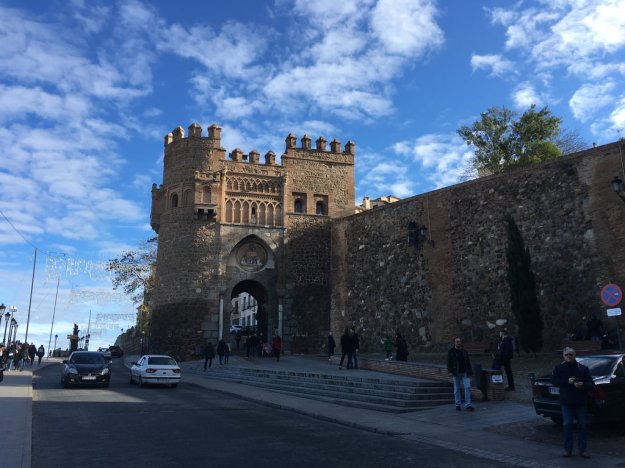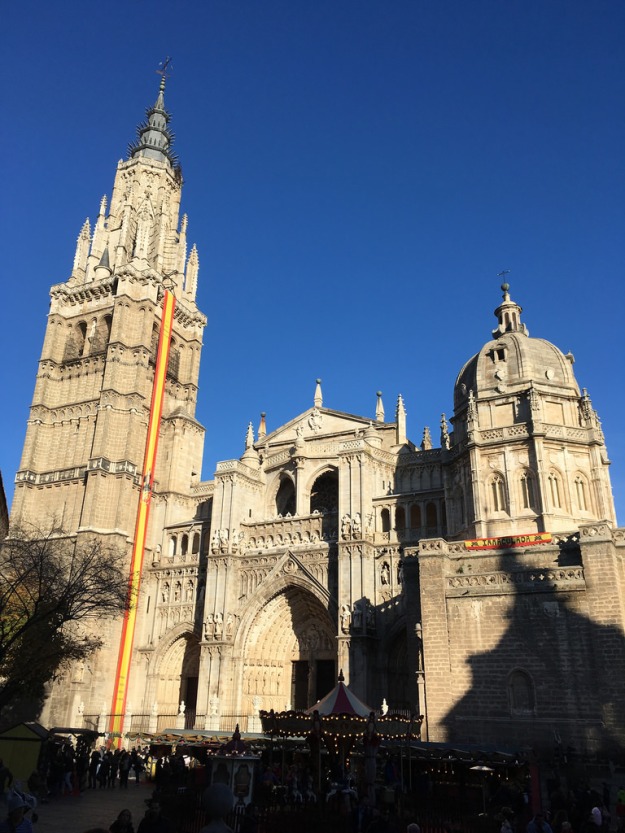Visit: 10th/11th December 2016
Toledo was the last WHS of my Portugal/Spain trip in December 2016. After touring Alcalá de Henares on my own I met Natalie at Madrid’s airport and the next morning we caught a coach from Spain’s current capital to its former one.
Toledo is a hilltop medieval city that bears witness (as so often in Iberian World Heritage Sites) to the meeting of cultures – successively the Romans, Visigoths, Moors and Christians, with Jews also present pretty much throughout.
The city’s cathedral, above, was for a long time the centre of Spanish Catholicism. As the Protestant Reformation swept Europe in the 16th century the Catholic authorities sought to retain believers by commissioning artists to paint vivid scenes from the life of Christ. One of the most famous of those artists today was the travelling Greek painter known as El Greco. He lived in Toledo for 38 years and left a legacy of paintings that justify a visit on their own. El Greco is known for his use of shimmering bold colours that seem to burst out of the canvas, combining elements of Byzantine art with Western painting. In the El Greco museum there is a collection of Jesus and the 12 Apostles which I found really impressive.
Toledo is defended on three sides by the Tajo river, much as Durham is by the Wear. We reached our hotel from the bus station by walking up the hill’s steep approach and then went out for lunch. Here follows a top tip: if you ever visit Toledo and enjoy informal but excellent dining, go to the newly-opened Mercado de San Agustín. It is a five-storey food court where you can choose from a range of options and get some really delicious tapas-style Spanish food. We enjoyed it so much we ate there twice. It was similar to the Time Out Market in Lisbon, where we had a great time in March 2015.


Toledo is a maze of narrow alleyways – like Venice without the canals. Local vendors play on the city’s medieval past of course, meaning disconcertingly many shops are packed to the gunwales with swords and daggers for sale. On Sunday morning the weather had changed from the blue skies in the picture of the cathedral, above, to a total white-out caused by thick fog. We set off for a walk to the Jewish quarter and the city’s other cathedral.

Natalie and I realised then that neither of us had ever been in a synagogue. We have been in plenty of churches and the occasional mosque (in my case only in Istanbul), but never a Jewish place of worship. So we took the opportunity to have a look around a former synagogue that is no longer in use here in Toledo.
I liked all the columns and the gold, but it did lack some atmosphere due its not being in active use. Hopefully we’ll get to see a working synagogue eventually.
And that was really the end of the visit. We caught our coach back to Madrid and then the Metro to Barajas airport. My 10 day trip to Portugal and Spain that had begun with the laurel forests of Madeira had come to an end, with a respectable 8 World Heritage Sites visited. I only have a few more to visit in Portugal (in the north and in the Azores), but plenty left to do in Spain, which is a real gold mine. This trip saw me cross the 100 mark (I think that was at the Monastery of Batalha in Portugal), putting my total after Toledo at 104. With 1,052 in the world at the time of writing, that’s just another 948 to go!






Pingback: • Old Town of Segovia and its Aqueduct | Tom's World Heritage Site travel blog